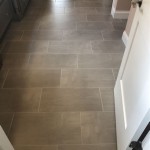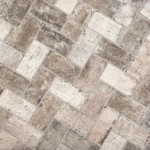Can You Tile on Cement Board Outside?
Cement board, also known as cement backer board, is a common construction material frequently utilized as a substrate for tile installations. Its composition, primarily cement, aggregate, and reinforcing mesh, lends itself to applications requiring moisture resistance and durability. The question of whether it can be successfully used as a tile substrate in exterior environments, however, warrants a detailed exploration of its characteristics, installation considerations, and potential limitations.
The primary advantage of cement board lies in its inherent resistance to water damage. Unlike gypsum-based drywall, cement board does not readily degrade or crumble when exposed to moisture. This property is crucial in exterior applications, where exposure to rain, snow, and humidity is inevitable. The relative impermeability of cement board minimizes the risk of substrate deterioration, which can lead to tile cracking, loosening, or even complete detachment.
While cement board offers a superior level of moisture resistance compared to other materials, it is not entirely waterproof. Water can still penetrate through the seams between boards, around fasteners, and even through the board itself over prolonged periods. This is why proper installation techniques and the use of appropriate waterproofing membranes are essential for exterior tile projects.
Furthermore, exterior applications subject cement board to freeze-thaw cycles. The expansion and contraction of water within the board during freezing and thawing can weaken the material over time, potentially compromising the bond between the cement board and the tile. This is particularly relevant in regions with significant temperature fluctuations throughout the year.
Understanding Cement Board Composition and Properties
Cement board is manufactured through a process that combines Portland cement, aggregate (such as sand or lightweight materials), and reinforcing mesh. This mesh, typically made of fiberglass, provides the board with structural integrity and resistance to cracking. The resulting material is dense, rigid, and relatively heavy compared to gypsum board.
The composition of cement board directly influences its performance in exterior environments. The cement provides the foundation for water resistance, while the aggregate contributes to its dimensional stability. The reinforcing mesh enhances its strength and prevents it from easily fracturing. The specific type and quantity of aggregate used can vary, impacting the board's weight, density, and overall performance.
Different manufacturers produce cement board with varying specifications. It is crucial to consult the manufacturer's documentation to understand the specific properties of the chosen product, including its intended applications, load-bearing capacity, and recommended installation procedures. Using a product outside of its intended design parameters can lead to premature failure and costly repairs.
The long-term performance of cement board also depends on its resistance to ultraviolet (UV) radiation. While cement itself is relatively unaffected by UV exposure, some additives or coatings applied to the board may degrade over time. This degradation can weaken the board's surface and compromise the tile bond. Therefore, it is advisable to select cement board products specifically designed for exterior use and that demonstrably resist UV degradation.
Proper Installation Techniques for Exterior Tiling with Cement Board
Successful exterior tile installations on cement board hinge on meticulous attention to detail during the installation process. Proper preparation, fastening techniques, and waterproofing measures are all crucial for ensuring a durable and long-lasting result.
The first step involves thoroughly cleaning and preparing the substrate. Any dirt, debris, or loose material must be removed to ensure a strong bond between the cement board and the framing. If the framing is uneven or damaged, it must be repaired or replaced before proceeding with the installation.
Cement board should be cut to size using appropriate tools, such as a score-and-snap knife or a circular saw with a fiber cement blade. Precise cuts are essential to minimize gaps between boards. When installing cement board on exterior walls, it is crucial to leave a small gap (typically 1/8 inch) between the boards to allow for expansion and contraction due to temperature changes. These gaps should be filled with a flexible sealant designed for exterior use.
Fastening the cement board to the framing requires using corrosion-resistant screws specifically designed for cement board. Galvanized or stainless-steel screws are recommended to prevent rust and ensure a secure hold. The screws should be spaced according to the manufacturer's recommendations, typically every 6 to 8 inches along the edges and every 8 to 12 inches in the field. Over-driving the screws can damage the cement board and compromise its integrity.
The seams between the cement board panels represent a potential weak point in the installation. These seams must be properly treated to prevent water infiltration. A common method involves applying fiberglass mesh tape embedded in a thin-set mortar designed for exterior use. The mesh tape reinforces the seams and provides a continuous surface for the tile installation.
Waterproofing Considerations for Exterior Cement Board Tiling
Waterproofing is arguably the most critical aspect of exterior tile installations on cement board. Even with proper installation techniques, water can still penetrate through the small pores in the cement board, around fasteners, and through imperfections in the grout. Therefore, a robust waterproofing membrane is essential to protect the underlying structure from moisture damage.
Several types of waterproofing membranes are available, each with its own advantages and disadvantages. Liquid-applied membranes, such as elastomeric coatings, are commonly used for their ease of application and ability to conform to complex shapes. These membranes are typically applied in multiple coats, creating a seamless, waterproof barrier.
Sheet membranes, such as self-adhesive or peel-and-stick membranes, offer another option for waterproofing. These membranes are typically more durable than liquid-applied membranes and provide a consistent thickness. However, they can be more challenging to install, particularly around corners and penetrations.
Regardless of the type of waterproofing membrane used, it is crucial to follow the manufacturer's instructions carefully. Proper surface preparation, application techniques, and curing times are essential for ensuring a successful and long-lasting waterproof barrier. Particular attention should be paid to sealing penetrations, such as pipes or electrical conduits, to prevent water from entering the wall cavity.
In addition to the waterproofing membrane, it is also important to use a waterproof grout when tiling on cement board outdoors. Epoxy grouts are known for their superior water resistance and durability compared to cement-based grouts. They are also more resistant to staining and mold growth. Cement-based grouts can be sealed with a grout sealer to enhance their water resistance, but regular maintenance is required to maintain the effectiveness of the sealer.
Finally, proper drainage is essential for preventing water from accumulating around the tile installation. Sloping the surface away from the building can help to direct water away from the wall. Installing weep holes at the base of the wall can also allow any water that does penetrate the system to escape.
In summary, utilizing cement board as a substrate for exterior tile installations is feasible, provided that meticulous attention is paid to proper installation techniques, waterproofing measures, and the selection of appropriate materials. Ignoring these crucial considerations can lead to premature failure and costly repairs.

How To Install Cement Board For Tile Projects Diy Family Handyman

Exterior Tile Installation On Walls Floor Trends

How To Install A Cement Board For Tiling Beaumont Tiles

Diy Outdoor Kitchen Build Part 3 Cementboard Accessories Tile And Trim

How To Install Hardiebacker Cement Board On Floors James Hardie Pros

Tile Backer Board By The Sq M Square Metre Packs Floor Or Wall Hard Insulation Cement 1200mm X 600mm

Cement Board Installation On Floors 5 Mistakes To Avoid Diytileguy

Tile Backerboard Material Options Fine Homebuilding

The Ins And Outs Of Cement Board Repair Grout Experts

Mesh Tape Don T Skip This Step Www Diytileguy Com
Related Posts








